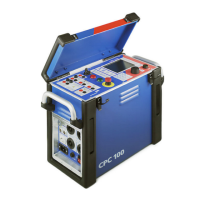CPC 100 V 3.20
Preface - 2
Preface
The CPC 100, in conjunction with its accessories or as a stand-alone unit, is a multi-purpose
primary test set for commissioning and maintaining substation equipment. It performs current
transformer (CT), voltage transformer (VT) and power transformer (TR) tests. Furthermore, it is
used for contact and winding resistance testing, polarity checks as well as primary and
secondary protection relay testing.
The various, partly automated tests are defined and parameterized via the front panel control of
a built-in embedded PC.
The functionality scope of the CPC 100 is described in detail in the chapter “Designated Use” of
the CPC 100 Reference Manual available in PDF format on the CPC 100 Toolset CD-ROM or
the CPC 100 Start Page.
Note: Any other use of the CPC 100 but the one mentioned above is considered improper use,
and will invalidate all customer warranty claims and exempt the manufacturer from any liability
to recourse.
Example of the separation of safe and high-voltage area using different OMICRON electronics
GmbH devices
► Do not enter the high-voltage if the red warning light of the CPC 100 is on.
General
The CPC 100’s outputs and the cables connected to them carry life-hazardous voltage or
current.
► Always obey the five safety rules and follow the detailed safety instructions below.
► Before connecting or disconnecting test objects and/ or cables, turn off the CPC 100 by
either the POWER ON/OFF switch or the Emergency Stop button. Never connect or
disconnect a test object while the outputs are active.
► Even if you switched off the CPC 100, wait until the red I/O warning light is fully
extinguished. As long as this warning light is lit, there is still voltage and/or current potential
on one or more of the outputs.
► Make sure that a test object’s terminals that are to be connected to the CPC 100 do not carry
any voltage potential. During a test, the only power source for a test object may be the
CPC 100.
► At their output sockets and especially in the cables connected to them, in operation the high-
current outputs 400A DC and 800A AC generate a significant amount of heat (approx.
300W /m at 800 A). To prevent burns, use gloves when touching the cables while in
operation or a short while after.
► Do not insert objects (e.g., screwdrivers, etc.) into any input/ output socket.
► Never use the test cards Quick and Resistance to measure the resistance of windings with
a high inductance because turning off the DC source results in life-threatening voltage
levels. For this kind of measurement only use either the special winding resistance test card
RWinding or the test card TRTapCheck.
► When measuring the ratio of voltage and power transformers make sure that the test voltage
is connected to the corresponding high-voltage winding, and the voltage of the low-voltage
winding is the one that is measured. Accidentally mixing up the windings can generate life-
threatening voltages within the transformer.
► Make sure that when testing a current transformer by feeding a test current into its primary
winding, all secondary windings are shorted. On open secondary windings, life-threatening
voltages can be induced.
► Use only one CPC 100 output at a time.

